Back to page 1
The Design
 |
“We did not skimp on making this an aesthetically pleasing environment,” Ryan pointed out. “The look and feel say ‘South Florida.’ We wanted the look of a Tommy Bahama’s store or a beautiful South Florida resort, where everything is clean, there’s a lot of wood and steel, and a lot of white. This design probably wouldn’t work in Arizona because we wanted something that fits nicely in this environment.”
However, when Knight looks at the layout and aesthetics of the park, “I see Arizona’s spring training parks, but on a smaller scale. The berms and wrap-around concourses are very much what fans see in the Cactus League. Of course, that makes Palm Beach’s park fairly unique in Florida.”
This brings up an important point: while it’s tempting to compare The Ballpark of the Palm Beaches with recently built spring-training facilities in Arizona, you shouldn’t. The stunning color schemes and grand exteriors of Salt River Fields, Camelback Ranch and Sloan Park in Arizona are great for the Phoenix area. It’s far more appropriate to compare the park in West Palm Beach to, say, JetBlue Park in Fort Myers or the renovated Ed Smith stadium in Sarasota. Both of those look gorgeous in their Florida environments.
The Ballpark of the Palm Beaches compares favorably with those two – as well as the other ten in Florida.
The new park’s aesthetics aren’t as lavish, but (much like the rest of the complex) it is exceedingly functional and spacious. No cramped concourses here — and it’s nice that natural light enters the walkway from both sides, as you can see below.
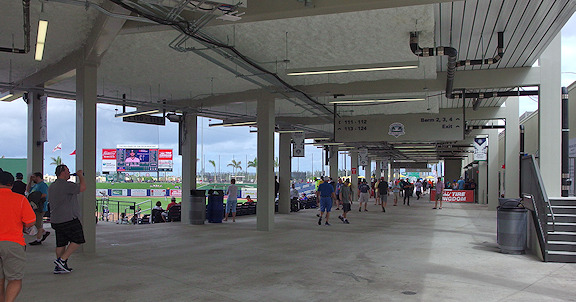 |
The fact that the concourse completely rings the field is also noteworthy because it’s only the second spring training park in Florida that was originally built that way – the other being Spectrum Field (formerly Bright House Field) in Clearwater. And stadiums not originally that way are scrambling to add that feature, i.e., Tampa, Port Charlotte, Fort Myers (Twins), Bradenton and Lakeland.
As you take a 360-degree walk around the field, you’ll not only be struck by how wide the concourse is, you’ll also notice how few obstructions like kiosks and food carts stand between you and the action on the field. In many parks, there are so many that the concourse might as well not be called “open.”
You’ll find a moderately size walk-in merchandise store as well as several kiosks with souvenirs. In addition to the large concession windows behind 1B and 3B, there’s also a mini food court behind home plate where the upper level fails to cover the main concourse, much like in Montgomery, AL or Pearl, MS. More on this area in the next section.
The upper level has group patios on each end (below), with the pressbox in the middle (where it’s supposed to be) and suites in between.
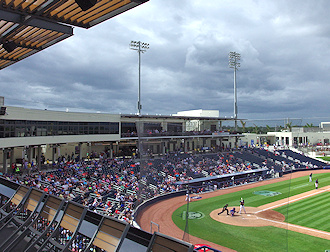 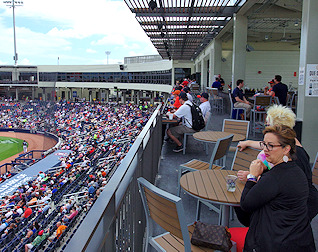 |
Early PR on the park said a “signature” feature would be an open-air bar with 32 beer taps. It was to be near the LF foul pole, and some site plans refer to it as the Budweiser Sand Bar. It wasn’t open for the first week of spring training, but when I visited, work was being done on it, so I assume it will be operational before the end of exhibition games.
The outfield is simply excellent. “There’s no doubt that the berm space there is the nicest of any of the 13 spring-training parks in Florida,” Knight concludes. “Clearwater used to be the best, but now it’s Palm Beach.” The berm not only extends from the end of one bullpen to the end of the other, there’s also a small grassy hill in foul territory by the LF pole (below left) – and it has its own netting to protect families sitting on it from screaming foul liners.
That spot also puts you in pretty good position to catch Astros players as they walk from the clubhouse to the 3B dugout. Alternatively, you can sit at one of the picnic tables at the top of that berm. “We wanted to have places where fans feel comfortable, whether they have kids rolling around on the berm or are with friends in a luxury suite,” Ryan pointed out.
  |
Astros players walk along the edge of their bullpen on their way to the field (above right), because the bullpens are parallel to the outfield walls near the foul lines. This also allows fans to interact with the pitchers and catchers there.
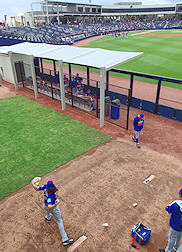 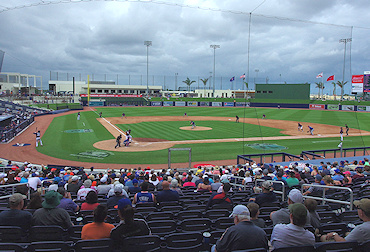 |
The main seating bowl is laid out intelligently, happily without special sections carved out for field-level suites or club seating. And because there wasn’t the desire for the park to have a huge capacity like the ones in Arizona, there are only about two dozen rows. That keeps an intimate feeling, even though the concourse is so wide.
The offices for the Astros (below left) are on the upper level of the clubhouse building and, just like in Kissimmee, they are beyond left field. There is a patio there just above the level of the concourse.
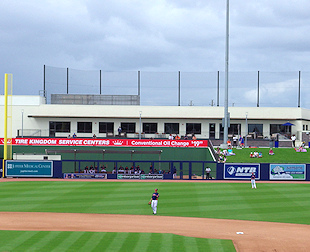 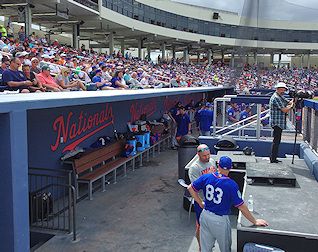 |
The Nationals’ offices are also on the upper level of their building, but remember it’s behind home plate. The view from their patio and office windows “is actually through the concourse onto the field, which is really unique,” said Stein. “We haven’t done that one before.” That was necessitated because they wanted their players to be able to walk from the clubhouse directly to their dugout under the stands (above right, where the players emerge up stairs at the left edge of the shot).
Now let’s talk about the all-important subject of shade. I mean, one reason people love Salt River Fields is because all of the rows above the cross aisle of the seating bowl are in the shadows at the start of a 1:00 exhibition game. By the end of the 3rd inning, usually 85% of all seats in the stadium are in the shade. One reason people criticize Camelback Ranch so much, on the other hand, is because of the lack of shade.
So it’s important. How did the architects do in West Palm Beach? Really well. “We wanted to get the maximum amount of shade for the amount of money we could invest in infrastructure,” Stein divulged. “The things we did in Arizona to get shade (e.g., at Salt River Fields) we had to do differently here. In South Florida when you study the solar angles in March, you learn you get better shadows when the third-base foul line points a little more to the west than due north. In Arizona, you get more shade when the line points a little more to the east.”
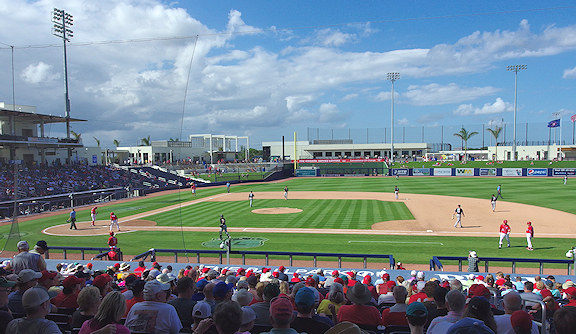 |
With the field oriented the right way and the upper level casting a shadow on the seating bowl, fans seated in the infield are largely in the shade (see above). Good.
The playing surface here is a grass called Platinum TE Paspalum. That’s noteworthy because of where else it’s used: at golf course all over Florida, at Marlins Park in Miami and interestingly at Minute Maid Park in Houston.
And the color scheme of the park is true to the “Tommy Bahama” theme desired by Reid Ryan – lots of light colors.
So the design of the interior is exceedingly functional, and gives both teams – as well as the fans – exactly what they wanted.
The Essentials
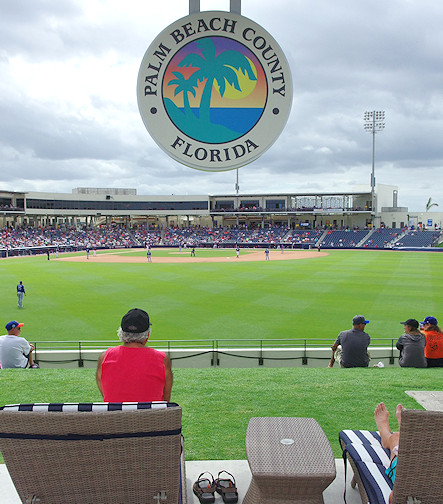 |
So what’s it like for fans of the Astros or Nationals to attend an exhibition game at The Ballpark of the Palm Beaches?
It’s not inexpensive, but it never is at a brand-new facility. Parking will run you $10, and remember it’s a pretty good walk from the lower lot to the entry of the park. If you prefer, valet parking is $20.
| Where’s the batter? |
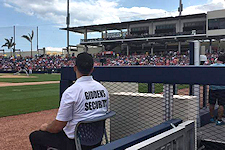 |
| One phrase you’ll hear said of every new park is “there’s not a bad seat in the house.” Well, that’s not exactly true here, as noted ballpark chaser Jay Thomas learned when he sat in his seat on the first row of section 102. As his photo above attests, he couldn’t see the batter because of the position of the dugout, padding and security guard. You might want to avoid that row … but, of course, you are right next to big league players. |
The tickets struck me as being expensive, but then I compared them to Jupiter, and I guess they are in line. Just like the Cards and Marlins at Roger Dean, the Astros and Nats both use the same price structure. And like in Jupiter, the prices vary depending on the expected demand for that opponent.
At Roger Dean, the “box seats” (which encompass almost the entire grandstand) are either $29 or $42, depending on the team they are playing that day. Bleachers down in the left-field corner are $15 or $25. General Admission is either $8 or $15. Keep in mind there really aren’t berms in Jupiter.
By comparison, in West Palm Beach, the range for Field Boxes (near the field, beyond the dugout) is $37-$56. Dugout Boxes, which span the majority of the infield, are $31-$47, while just behind those are the Infield Boxes, which cost $28-$42. There is also a category called Outfield Reserve, which are all of the rows down the foul lines. They cost $23-$32. To sit on the Banana Boat Lawn, it will cost $15-$20.
To put it in perspective, a seat in the infield about 15 rows from the field against the Red Sox would cost you $42 at either West Palm Beach or Jupiter. What amounts to a General Admission ticket would be $20 in WPB and $15 in Jupiter.
Keep in mind that if you want to snare autographs from the Astros, Outfield Reserve seats in sections 100 and 101 (below left) will put you in a prime position.
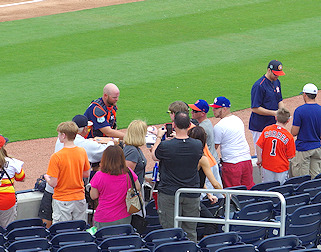 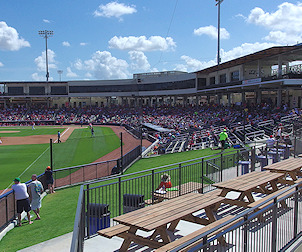 |
During my visit, I noticed how few people were on the lawn. I’m used to seeing hundreds or even thousands sitting on the berms in Arizona. Perhaps as fans in Florida become more accustomed to the concept, more folks will make use of it — and they should, because it’s an outstanding lawn in West Palm Beach.
But this brings up a potentially sore subject: unlike at other Florida venues, there haven’t been sell-outs yet at The Ballpark of the Palm Beaches. I asked Brady Ballard, the General Manager of the complex, about it. He explained that “We’re still building a fan base here. Also, the early start of exhibition games this year because of the World Baseball Classic hurt attendance all over the Grapefruit League.” And that is a valid point.
The main merchandise store is behind 3B. It’s not as large as the newly renovated stores in Tampa or Lakeland, but there’s lots of natural light and the souvenirs are displayed well. There’s a variety of Astros, Nationals and generic spring-training items and apparel.
I can’t remember seeing $40 men’s t-shirts at other spring-training shops, but they have ones sporting the teams’ logos that cost that in West Palm. Tees without the logos tended to be $30 (below right). There was even one with just the ballpark logo, and it was only $20. Women’s tees were mostly $35. Most of the kids’ t-shirts were $20. Short-sleeve adult polos were $70 and $75.
 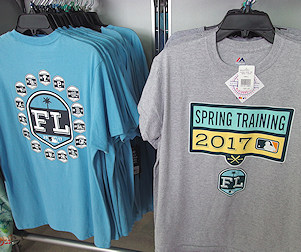 |
Fitted caps are definitely pricey at $45. Most adjustable caps are a more-reasonable $25. Kid’s caps are $15 and $20.
The food-service vendor here is Professional Sports Catering, an arm of the top-shelf Levy organization. More importantly, they specialize in concessions at Minor League ballparks, so the scale of their model is about right for this facility. In trying to stick to my rule of not comparing Florida spring-training facilities to Arizona, I’ll avoid saying that the concessions aren’t as good as at Salt River Fields or Sloan Park (both are in Arizona, of course) … so I’ll just say that they are good for a Grapefruit League facility. Is there the variety and quality of JetBlue Park in Fort Myers? Not hardly, but there they are feeding 10,000 Red Sox fans every game, not 4,000 or so Astros or Nats fans like in West Palm.
I like that there is an attempt to have stands with food and drink items geared to Texas fans and others for visitors from the Washington area. For instance, the H-Town Bar sells Shiner Bock beer ($7.50 for 16 oz.). There’s also a Lone Star Cantina cart with soft tacos (two for $8) and Super Nachos ($12). For Nats fans, there’s The District Taproom with daiquiris ($11) and cocktails ($9).
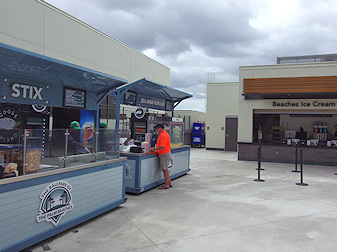 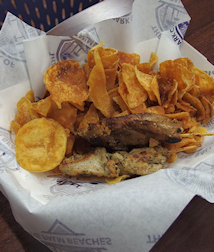 |
My favorite concession area is directly behind home plate (above left). It might overstate things to call it a food court, but here you’ll find The District Taproom, Beaches Ice Cream Café and three food carts, including Stix, which serves grilled chicken or pork on a stick with home-made kettle chips for $12 (above right). I bought one of each type and enjoyed them very much.
While you’ll have no problem finding ballpark staples like hot dogs, burgers, tenders and snow cones, there are some deluxe versions of the standard fare. There’s a burger cart that will put pulled pork on your order, or beer cheese with peppered bacon (either is $12). The Hickory Sausage Shack has a half-pound dog and a jumbo brat (again, either is $12). And a cart with treats sells a vodka snow cone for $8.
Since the fancy bar with 32 taps wasn’t open yet, I can only tell you about the beers in the rest of the park. Drafts in a souvenir cup go for $10.50, while regular 16-ounce drafts are $7.50. Premium beer (think Michelob Ultra) is $9.50 for 16 oz. So you’ll pay a pretty penny to satisfy your thirst.
While you’re actually sitting in your seat enjoying the game, you’ll appreciate the state-of-the-art video board in right center field. Normally, you see these in left center, but it might’ve blocked the view of the field from the Astros offices if it had been there.
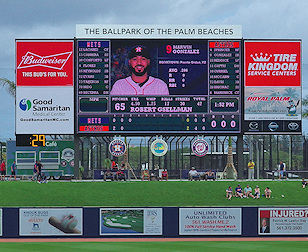 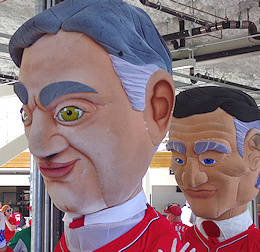 |
The sound system is excellent, by the way. Several reporters in the press box questioned the odd musical taste of the person who put together the playlist that filled the air for the 90 minutes leading up to game time, but the sound itself was perfect. And not overly loud, like it is at the Braves’ stadium at Disney.
When several teams renovated their spring-training ballparks, they added play areas for kids (Peoria and Lakeland did excellent jobs with this). There’s nothing like this at West Palm Beach yet, but there is certainly room to do this if they choose to in the future.
But that’s not to say that a family with small kids won’t enjoy themselves at an Astros or Nationals exhibition game. Quite to the contrary. For one thing, the Astros’ mascot Orbit is at their games, and the racing President mascots (made famous at Nats games in DC) are there as well … but as you might be able to tell from the photo, the Presidents might seem a little creepy to a little tike up close.
Summary
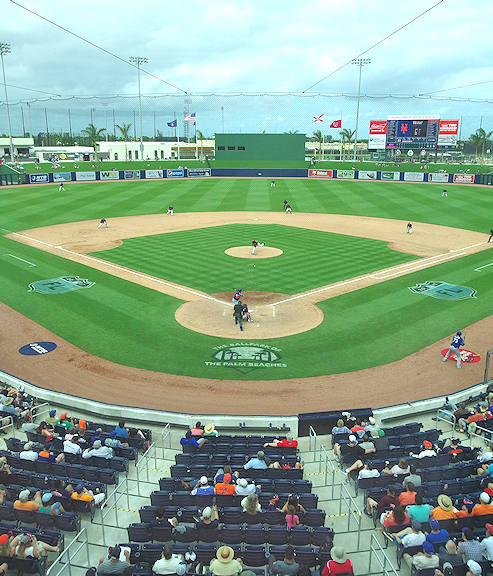 |
While the stadium at the new complex is very good and perhaps brings a little bit of the Cactus League to Florida, it’s the player development areas that really shine, and provide exceptional access for fans, just as Ryan wanted. “The Astros’ side of the complex is the best in Florida,” Knight concluded. “They really did right by the fans.”
Stein added that “Part of our job (as architects) is to engage the fan in this wonderful pastime in ways that are not familiar. Fans will come here and find there are 25 ways to see a ball game, and only one of them is to sit in your seat.”
“What Mo said is what I’ve always said: you want the fan to have a lot of different experiences,” echoed Ryan. “We want every type of fan to enjoy their own experience at this ballpark, and I think we’ve achieved that.”
And there are many special touches around the complex that add to the experience of the fans — from pathways through the practice fields to the wonderful Florida landscaping. And if you get lost searching for your team’s side of the complex, just look for the massive team logos that are in front of the entrances to their workout areas and offices (below).
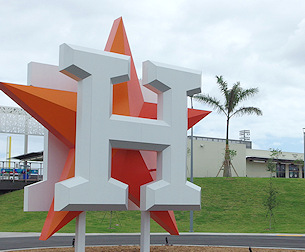 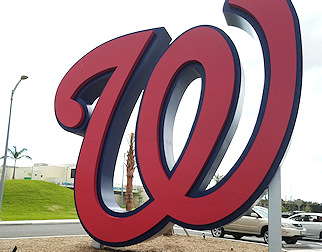 |
Of course, the purpose of spring training (aside from its obvious revenue potential) is to prepare the players for the regular season. “If what we’ve created contributes to that, then we’ve been successful,” said Stein. “If we’ve connected them to their fans in a way they’ve never been connected before, and we’ve given the fans the opportunity to really experience baseball, then we’ve done our job. That’s what it’s about.”
And now fans are enjoying the unprecedented access to their favorite players, and watching exhibition games in new ways. Plus the Astros and Nats have access to nearby teams to play. When you add it all up, you have to conclude that the newest addition to the spring-training scene is a success.
Let the world know what you think of The Ballpark of the Palm Beaches as well as this review in the comments area below.
The Ballpark of the Palm Beaches is by far the best facility in Florida. I would compare this ballpark as a slightly scaled down version of Sloan Park (Cubs) with a touch of Surprise (Rangers/Royals). At least HKS has learned from its two mistakes made at Camelback Ranch / Glendale (Dodgers/White Sox) that being shade and sightlines.
Good insight. Thanks for taking the time to write!
Where is the best place to stand to catch an away team exit on their way to buses if they played the Nationals?
Yours is a great question, so I went straight to Mo Stein, the head of the architectural firm that designed the complex and its ballpark. Here’s his response:
Visiting players enter and exit through the right field corner access point. You can stand on the concourse and the players will walk right below you to and from the field. The building on your right is the visitor and umpire clubhouse. The bus will be right in front of that.
Looking at seats between the dugouts, several show pole-impaired views. Is that an issue?
No, it’s not. Between you and the field is the screen, but the pillars that support the upper level are at the rear of the lower level seats. Some have complained about railings that impede the view of folks on the front row (especially at the end of the dugouts), but above the first row, I don’t think there is a problem.
Looking at seats in the lower part of 102 and it says obstructed by dugout. Do you know how obstructed this view is?
Last year, fans in the first couple of rows in Section 102 complained they couldn’t see the batter clearly because of the railing and security folks at the outfield end of the 3B dugout. That is probably a good place to access players going in and out of the dugout, but for watching the game, you might want to stay away from the first couple of rows.
Where is a good place to park and catch pitchers and catchers in mid-February. I have three sons who love to watch the practices and get some autographs.
It depends on whether you’d rather see the Astros or the Nationals. Astros fans should park in the lot in the northwest corner of the complex, off Haverhill Road. If you’re more interested in the Nationals, park in the lot on the southern edge of the complex. Either way, you’ll be really close to your preferred team’s practice fields. Both teams provide excellent access to their players — although the Astros make it a little easier, in my opinion.
I have 20/20 vision and could barely read the scoreboard from home-plate seats. Had trouble seeing the score, number of outs, and the count. Scoreboard is overly cluttered with huge pictures and visuals, but the details (that matter) were hardly visible. Otherwise, great little stadium…